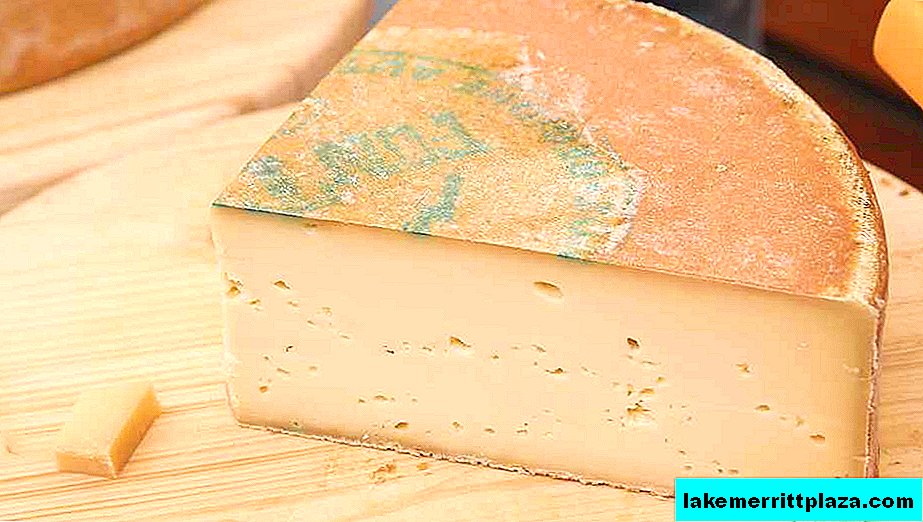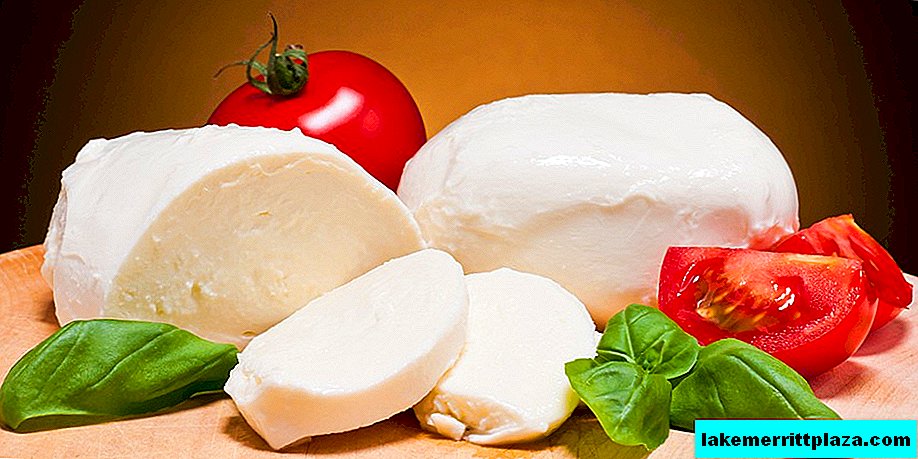Fontina (Fontina) - this is not the name of the temperamental Italian, but the name of the next cheese elder. He was born in the Valle d'Aosta region and has survived to this day almost unchanged. The cheese is noticeably different in taste from its alpine counterparts. We are not going to intrigue for a long time and offer you to get to know him better.

Story
The first mention of the fountain is not found in official documents, as in most cheeses. It was captured in the 15th century on a fresco in the castle of Issonier (castello di Issogne) in the Valle d'Aosta region. It presents a workshop with a large number of cheese heads.

It is assumed that the name "Fontina" originates from a territory called Fontin, where his recipe was developed. Other historians consider the village of Fontinaz to be the ancestor of the cheese name. The third version is based on the fact that it got its name from the old French term "fontis" or "fondis", which was used to indicate the ability of products to melt when heated.
The term "Fontina" for cheese was first mentioned in 1477. The doctor Pantaleone da Confienza wrote about him in his treatise Summa Lacticinorum.
- Read also: types of Italian cheeses from A to Z
The first classification dates back to 1887: the report of the dairy factory describes the product "Le Fontine di Val d'Aosta". In the 30s and 40s of the 20th century, the Italian Ministry of Agriculture and Forestry made its second classification.
In 1955, by decree of the President of the Republic, Fontina was assigned to the category of controlled name origin (DOC) products. So finally, a full-fledged study of cheese was carried out.
In 1957, manufacturers convened a Consortium to control the production and sale of cheese. In the first year, 75,000 goals were sold, after 10 years - 150,000, at the end of the 80s the sales figures reached 300,000. In 1995, by decision of the European Union, Fontina Valdostana was given the Protected Designation of Origin (DOP).
Technology
The production of fountains and raw materials for it takes place exclusively on the territory of the Valle d'Aosta region. Milk is obtained only from certain breeds of cows (Valdostana Pezzata rossa, Valdostana Pezzata near), which graze on high mountain pastures in the summer or feed on local hay in the winter.
For cooking, whole milk of one milk yield is used. After milking, it goes into the process in no more than 2 hours to preserve all the beneficial properties and aroma. Before curing, the raw materials undergo heat treatment at temperatures above 36 degrees.
Coagulation occurs in copper or steel boilers by adding calf rennet and heating to 34-36 degrees and lasts at least 40 minutes. Then the cheese maker breaks the clot into granules the size of a grain of corn.
The boilers are heated to 46-48 degrees until the master decides that the whey is sufficiently clear. After this, the mass is left alone for at least 10 minutes. Then, the precipitate is manually transferred to the forms covered with a cloth to drain the liquid. At the stage of pressing, lasting 24 hours, markings are applied to the heads (manufacturer's code and production date) using a casein plate, which will later become part of the crust. Cheese is salted by immersion in salt water for 12 hours.

Fontana ripening occurs in caves carved into the rocks. Such premises maintain a temperature of about 10 degrees and a humidity of 90% year-round.
Exposure lasts more than 80 days. During this time, the heads are wiped, turned over and salted with a dry method.
After confirming the quality of the heads by the experts of the Consortium, the ripened cheese is marked with a logo ("Fontina DOP" with a stylized image of mountains) using a seal.
To make one fountain, about 100 liters of milk are needed. To date, 400,000 goals are produced annually.
Specifications
Fontina is a medium-hard semi-hard cheese. It has an elastic, soft texture with a small number of unevenly distributed eyes. It can be either ivory or straw. It has a characteristic sweet taste with nutty notes, which becomes more pronounced with age.

The ideal head weight is from 7.5 to 12 kg. The shape is cylindrical with slightly concave sidewalls 7-10 cm high and flat faces with a diameter of 35-45 cm. The crust is brown, thin, compact. The intensity of its color increases with maturation.
The amount of fat in dry matter is 45%. Fontina is distinguished by a high content of live lactic acid cultures. In Italy there are variations of "Fontinella", "Fontal", "Fontella", not belonging to the category of DOP. They are much softer than the original product.
What to eat, how to store and how to replace

Fontina is widely used not only in Italian cuisines, but also among cooks around the world. It is used independently in the cheese plate, goes well with fresh bread or croutons. Due to its low melting point (60 degrees), it is ideal for hot sandwiches and pizza.
Grated fontina is added to soups, dumplings, cereals, meat. They are seasoned with baked vegetables and salads. It is unsurpassed in the composition of polenta and risotto. Cheese is considered the undisputed leader in the preparation of fondue.
As for alcoholic beverages, the best option for it would be red wine like Nebbiolo and Merlot.

It must be stored in the least cold place of the refrigerator, wrapping with cling film. But, if you are a perfectionist, you should wrap the fountain with a damp linen cloth and place it in a glass vacuum container. Before serving, the product should be obtained at least half an hour.
How to replace the fountain in recipes? This is a controversial question, since castling can be done with ease, but the loss of the flavor of the dish is inevitable. Alternative cheeses: Russian, Dutch, King Arthur, stall, maasdam.
We can’t get past the recipe for the famous cheese fondue.
Fontina fondue recipe
In order to make fondue fondue, you need 20 minutes and just a few components:
- 200 g of fountains;
- 125 g of whole milk;
- 15 g butter;
- 2 egg yolks.

Preliminary preparation: Cut the cheese into slices and send it to a narrow, high pan or a special container for fondue. Pour milk into it and leave it in the refrigerator for several hours. Heat the prepared mixture in a water bath, add oil and yolks. Continue heating until a uniform, thick cream is obtained. You can salt and pepper the dish to taste. But it is worth considering that the cheese is also quite salty. They use fondue, dipping pieces of bread or their favorite fruit in it.
Calorie content and benefits
Like all whole milk cheeses, Fontina has a high calorie content of 343 kcal per 100 g. It contains:
- Proteins 27 g;
- Fats 28 g;
- Carbohydrates 0 g.
Despite the fact that most of the cheese fats are saturated, the cholesterol content in it is "not fatal" - 80 mg / 100 g. Its quantity is reduced in cheeses cooked during the period of "green pastures" (May - October). At the same time, the concentration of unsaturated fatty acids (omega-3 and omega-6) increases, which improve the condition of hair and nails, suppress inflammatory processes, and prevent cardiovascular and neurological diseases.

Fontina is characterized by a high protein content, and together with them essential amino acids. The amount of salt in it is less than in other varieties, while the mineral content is significant. 100 g of the product covers 86% of the daily value of calcium and 68% of phosphorus. These are essential components of healthy bones, muscles, teeth and skin, preventing the development of osteoporosis.
A portion of cheese (50 g) saturates the body with 26% of the daily intake of vitamin A, the main fighter for sharp vision and toned skin.
According to the content of live lactic acid bacteria, it is comparable to kefir or yogurt. Therefore, it is especially valuable for those who have digestive problems.
Due to its nutritional properties, the fountain is an excellent product for people of all ages and lifestyles. It will enrich the diet of a child and a pregnant woman, an athlete and an elderly person, and help those who are weakened by an illness or lack of appetite to recover.
Price in Italy and Russia
Finding a fountain in Italy is easy enough. You can buy this cheese loved by Italians at a price of 13 to 18 euros per 1 kg of the original product.

Unfortunately, we were not able to find a proposal for the sale of fountains in Russia either in supermarkets or on the shelves of Internet sites. The score is 1-0 in favor of rest in Italy.
On this acquaintance with the cheese long-liver came to an end. We hope you find everything you were looking for and a little more. Live on your own, love fully, relax in a variety of ways and remember: "I took up the fondue, don’t say that you won’t go to Italy for the fountain!"








